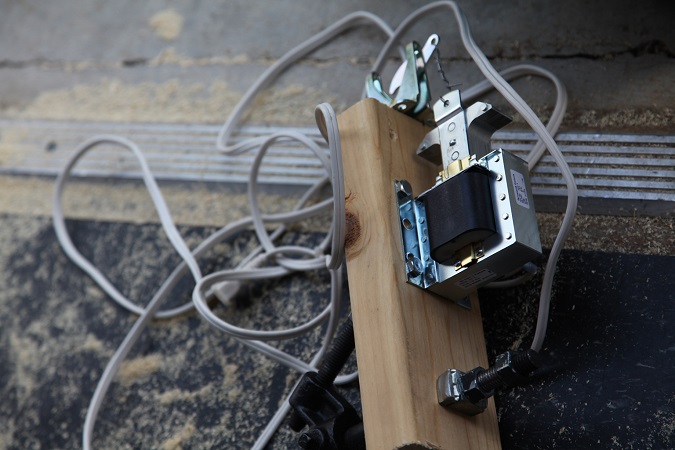Linear Solenoid Kabuki Drops
What is a Solenoid?
In its basic form, a solenoid is a long, thin tight coil of wire that produces a uniform magnetic field inside the coil pocket when an electric current is passed through it.
A Linear Electromechanical Actuator (LEMA), or simply Linear Solenoid, includes a plunger designed to fit into the solenoid coil pocket. This plunger is typically made from a ferrous square or round metal bar.
When an electrical current is passed through the coil of wire, it behaves like an electromagnet and the plunger is “pulled back” or attracted towards the center of the coil by the magnetic flux setup within the coil’s body.
It is generally spring-loaded so the plunger returns to its neutral position when the power to the solenoid is cut.
The concept of a linear solenoid is to convert electrical energy into a mechanical pushing or pulling force or motion, hence the term “electromechanical actuator”.
Generally, in engineering and in the context of Kabuki Drop systems, when the term solenoid is used, it refers to a linear solenoid.
The solenoid, which is cylindrical in shape, can be purchased at large general hardware stores or electronic parts stores.
Typical Linear Solenoid
For more detailed technical information on linear solenoids, visit: G.W. LISK Company Inc
Electronic “Pull Pin” Kabuki Drop
This a basic linear solenoid Kabuki Drop system that has a pin secured to the plunger in the form of a threaded rod that is screwed into the plunger head.
The solenoid cylinder is mounted and encased into a housing (a box made of plastic or metal) and the plunger pin extends out of the housing through a hole drilled through the side of the housing.
The entire housing is clamped onto a truss bar and this serves as the drop point for the Kabuki curtain.
The curtain is hung on the pins of the drop points via grommets fitted across the top edge of the curtain.
A cross section view of the solenoid cylinder is shown below.
Image Credit: Magic Kabuki Drop
When electricity is passed through these solenoids, the plungers retract into the housing, causing the pins to be pulled out of the Kabuki curtain which subsequently falls to the floor.
Image Credit: Magic Kabuki Drop
Image Credit: Magic Kabuki Drop
Electronic “Lever Release” Kabuki Drop
A linear solenoid can also be used to release a lever that holds up the Kabuki curtain instead of simply retracting a plunger pin as described in the basic solenoid system above.
It can also be used to pull open a gate latch or custom-fabricated arm.
Linear Solenoid Used to Release Safety Pin of a Marine Shackle
Photo Credit: Tom Howard (As posted in the Blue Room forum)
Linear Solenoid used to Open a Gate Lock that Releases a Curtain
Photo Credit: Connection Pointe Production Team
Photo Credit: Sew What? Inc
 Release Solenoid Previously Manufactured by Flints
Release Solenoid Previously Manufactured by Flints
Magic FX’s Power Drop
Photo Credit: MagicFX
Photo Credit: Rent What? Inc
Lever Arm Solenoid Kabuki Drop Manufactured in China
Photo Credit: Chabuki Curtain Release System
Patent for an Electronic Lever Release Kabuki Drop
Photo Credit: Jesus Chuy Fragoso
Electronic “Shake & Drop” or “Rolling Pole” Kabuki Drop
This is a modern version of the traditional “rolling pole” Kabuki Drop but uses a linear solenoid to trigger a spring loaded gate latch to rotate the pole with drop points instead of a pull cord.
Check out a Double Kabuki Drop in action using an electronically-powered modern day “Rolling Pole” Kabuki Drop system in the video below:
One manufacturer that offers a variation of this system is Showtex. Their system is described in their operation manual here.
The Showtex system uses a solenoid system that drops an aluminum bar with drop points (pegs) at a downward angle to effect the curtain drop.
Photo Credit: Showtex
Electronic “Pins & Loops” Kabuki Drop System
The video below describes an electronic version of the “Pins & Loops” Kabuki Drop system. Instead of a pull cord as used in the manual version, this system uses a tensioned-spring to pull all the pins from the loops to release the curtain.
Unlike all other electronic systems, which requires the use of multiple individual solenoid drop point units, this system uses only one linear solenoid that keeps the spring pulled open when the Kabuki Drop is set up. When triggered, the solenoid releases the spring that pulls all the pins from the loops and activates the curtain drop.
https://www.youtube.com/watch?v=X07AF1VL6Q0
Read Previous Topic:
Electronic Kabuki Drop Systems
Read Next Topic:
Electromagnetic Kabuki Drop Systems

Disclaimer: This is a free resource site for educational purposes. To better illustrate points made in the articles, images have been used to accompany the information. Photo credits and links to the source material are given where applicable.
If you are a copyright holder for any of the images and do not want your image used in this resource site, please contact us at info(a)illusionbookstore.com and we will remove the image within 24 hours.













